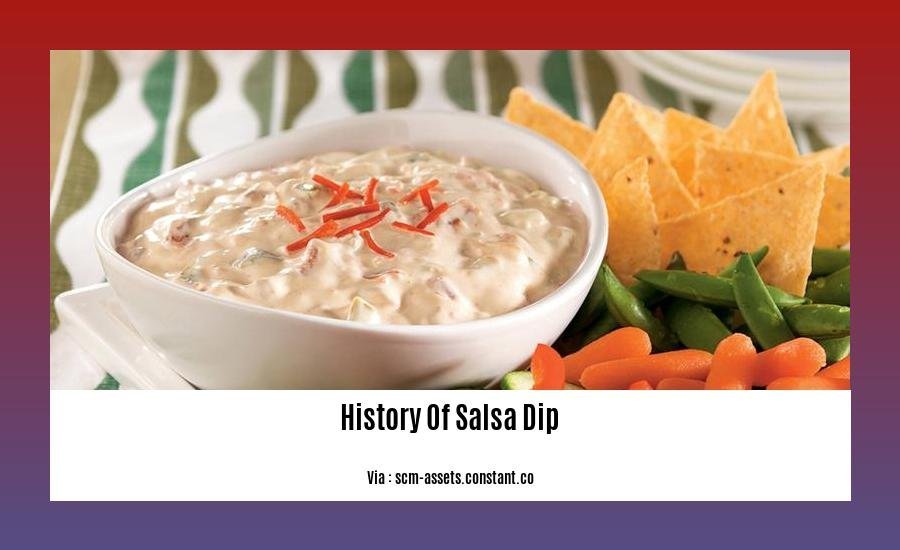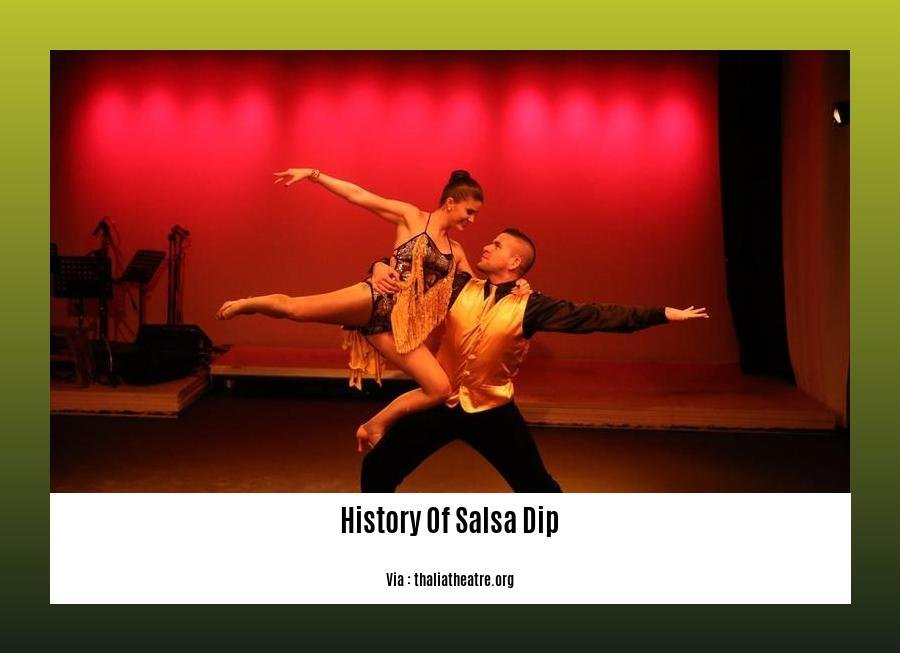Get ready to embark on a delectable journey through time as we unveil the rich history of salsa dip in our article “[A Culinary Journey Through Time: Unveiling the History of Salsa Dip].” From its humble origins in ancient Mesoamerican civilizations to its transformation into a beloved global condiment, we’ll explore the fascinating stories and anecdotes that have shaped the evolution of this iconic dip.
Key Takeaways:
- Salsa originated in ancient Mesoamerican civilizations.
- The Spanish named it “salsa” in the 16th century.
- Salsa arrived in the U.S. through Mexican restaurants.
- Tomato-based salsas became popular in the 1980s.
- In 1992, salsa sales surpassed ketchup sales in the U.S.
- Salsa comes in many varieties, including tomato-based, verde, pico de gallo, fresca, and guacamole.
History of Salsa Dip

From its ancient Mesoamerican roots to its global culinary triumph, salsa’s journey is a captivating tale of culture, flavor, and culinary evolution.
The Genesis of Salsa: A Culinary Masterpiece from Ancient Mesoamerica
Salsa’s lineage can be traced back to the ancient civilizations of Mesoamerica, where the Aztecs, Maya, and Incas crafted their unique versions of this versatile condiment. These early salsas, made from tomatoes, chillies, and herbs, were not just mere accompaniments; they held significant cultural and culinary significance.
Spanish Influence: The Arrival of a New Name
When the Spanish arrived in Mesoamerica, they encountered the vibrant world of salsa and were captivated by its flavors. In 1571, Spanish priest Alonso de Molina documented the term “salsa” for the first time, officially recognizing its culinary prowess.
Culinary Crossroads: The Evolution of Salsa in the United States
Salsa’s journey continued with the rise of Mexican restaurants in the United States. These culinary havens introduced Americans to the delights of salsa, showcasing its versatility as a condiment and a dipping sauce.
In the 1980s, tomato-based Mexican-style salsas gained unprecedented popularity in the U.S., becoming a staple in homes and restaurants across the nation. In 1992, salsa sales surpassed those of tomato ketchup, cementing its status as America’s favorite condiment.
A Culinary Symphony: The Diverse World of Salsas
Salsa’s diversity is its defining characteristic. Each region and culture has its own unique take on this culinary masterpiece, with a vast array of ingredients and flavors to explore.
Tomato-based salsas: The most popular type, made with tomatoes, onions, cilantro, and chillies.
Salsa verde: A tomatillo-based salsa with a tangy, slightly sour flavor.
Pico de gallo: A fresh salsa made with chopped tomatoes, onions, cilantro, and chillies, served raw.
Salsa fresca: A refreshing salsa made with fresh ingredients, often served with seafood.
Guacamole: A creamy avocado-based salsa, often seasoned with lime, cilantro, and chillies.
Salsa: A Culinary Icon
Salsa’s journey from its humble beginnings in Mesoamerica to its global culinary triumph is a testament to its universal appeal. It represents a harmonious blend of flavors, cultures, and traditions, capturing the essence of culinary artistry.
Whether enjoyed as a condiment, a dip, or a standalone snack, salsa continues to captivate taste buds around the world, leaving an indelible mark on the culinary landscape.
Dive into the captivating past of quesadillas, a beloved Mexican dish that has been tantalizing taste buds for centuries. History of Quesadillas
Unravel the fascinating tale of salsa food, a vibrant and flavorful ingredient that has revolutionized the culinary landscape. History of Salsa Food
Delve into the rich history of salsa sauce, a culinary masterpiece that has transformed ordinary meals into extraordinary culinary experiences. History of Salsa Sauce
Salsa and Mexican Cuisine

Hello there, fellow food enthusiasts! Grab a tortilla chip and get ready for a delightful journey into the realm of salsa dips and their intricate connection to Mexican cuisine.
Salsa: A Culinary Gem
Salsa is not just a condiment; it’s a culinary masterpiece, a symphony of flavors that dances on your taste buds. Its origins can be traced back to ancient Mesoamerica, where civilizations like the Aztecs, Mayans, and Incas crafted their own unique versions of this versatile sauce.
Salsa’s Transformation
Over the centuries, salsa has undergone a remarkable transformation, evolving from a staple ingredient in traditional Mexican dishes to a beloved global condiment. It’s a testament to the power of food to transcend borders and cultures.
Salsa Across the Globe
Today, salsa has become a global culinary triumph, gracing tables and tantalizing taste buds worldwide. Its popularity soared in the United States during the 1980s, thanks to the rise of Mexican restaurants and the growing appreciation for its vibrant flavors.
Key Takeaways
- Salsa has its roots in ancient Mesoamerica, where civilizations like the Aztecs, Mayans, and Incas created their unique versions.
- Salsa gained international recognition through Mexican restaurants in the United States, showcasing its versatility as a condiment and dipping sauce.
- In the 1980s, tomato-based salsas gained immense popularity in the U.S., surpassing tomato ketchup in sales by 1992.
- Salsa represents a harmonious blend of flavors, cultures, and traditions, embodying the essence of culinary artistry.
Sources:
Salsa (food) – Wikipedia
The History of Salsa
Salsa in Global Cuisine
Salsa, a versatile culinary creation, has transcended borders and cultures to become a cherished condiment across the globe. Its journey through time has been marked by fascinating stories and a rich tapestry of flavors. Let’s embark on a culinary adventure to unravel the history of salsa and its triumphant global conquest.
Salsa’s Ancient Roots: A Mesoamerican Legacy
Salsa’s origins can be traced back to the ancient civilizations of Mesoamerica, where the Aztecs, Mayans, and Incas crafted unique versions of this zesty condiment. Made from a blend of chili peppers, tomatoes, and other spices, salsa held cultural and culinary significance, often gracing royal tables and sacred rituals.
Spanish Influences: The Arrival of Tomatoes
The arrival of Spanish conquistadors in the 16th century marked a pivotal moment in salsa’s evolution. They brought tomatoes, a native South American fruit, which quickly became a staple ingredient in Mexican cuisine. The fusion of indigenous and European culinary traditions gave birth to new and exciting salsa variations.
Salsa’s Global Expansion: A Culinary Sensation
In the 20th century, salsa’s popularity soared beyond the borders of Mexico. Mexican immigrants introduced this vibrant condiment to the United States, where it quickly gained traction in restaurants and homes. The versatility of salsa as a dip, condiment, and cooking ingredient fueled its rise to global stardom.
Key Takeaways:
- Salsa originated in ancient Mesoamerica, where it held cultural and culinary significance.
- The introduction of tomatoes by Spanish conquistadors transformed salsa, creating new and exciting variations.
- Salsa’s global expansion in the 20th century was driven by Mexican immigrants, who introduced it to the United States and beyond.
- Salsa’s versatility as a dip, condiment, and cooking ingredient contributed to its global popularity.
References:
- Salsa History: A Spicy Journey Through Time
- The Culinary History of Salsa
Cultural Impact of Salsa
Salsa, a vibrant and versatile condiment, boasts a rich and diverse history deeply intertwined with Mexican culture. Its culinary journey has taken it from humble beginnings in ancient Mesoamerica to a global condiment embraced by diverse cuisines worldwide.
Salsa’s Roots in Ancient Civilizations
Salsa’s origins can be traced back to pre-Columbian civilizations such as the Aztecs, Mayans, and Incas, who crafted unique versions of this flavorful condiment using native ingredients like chili peppers, tomatoes, and spices.
Spanish Influence and the Spread of Salsa
The Spanish conquistadors encountered salsa during their conquest of Mesoamerica in the 16th century. They were captivated by its unique flavors and began to incorporate it into their cuisine, leading to the fusion of Mexican and Spanish culinary traditions.
Salsa’s Global Journey
Salsa’s journey beyond Mexico began in the 19th century when Mexican immigrants brought their beloved condiment to the United States. It gained popularity in Mexican restaurants and gradually found its way into American kitchens, becoming a staple in Tex-Mex cuisine.
Salsa in Modern Cuisine
Today, salsa has become a ubiquitous condiment, enjoyed in homes and restaurants worldwide. Its versatility and ability to enhance various dishes have made it a global culinary sensation.
Key Takeaways:
- Salsa’s origins can be traced back to ancient Mesoamerican civilizations, where it was crafted using native ingredients and techniques.
- The Spanish conquest of Mesoamerica led to the fusion of Mexican and Spanish culinary traditions, contributing to salsa’s evolution and spread.
- Salsa’s journey beyond Mexico began in the 19th century when Mexican immigrants brought it to the United States, where it gained popularity and became a staple in Tex-Mex cuisine.
- Modern cuisine embraces salsa’s versatility, using it as a condiment, dip, and ingredient in various dishes worldwide.
References:
- The Ancient Origins of Salsa
- Salsa History: Who, Where, & When?
FAQ
Q1: Where did salsa originate?
A1: Salsa originated in ancient Mesoamerican civilizations, such as the Aztecs, Mayans, and Incas, who used it as a condiment and dipping sauce.
Q2: How did salsa get its name?
A2: The term “salsa” was first used to refer to the condiment in 1571 by Spanish priest Alonso de Molina. In Spanish, “salsa” means “sauce”.
Q3: When did salsa become popular in the United States?
A3: Salsa gained popularity in the United States in the early 1900s with the opening of Mexican restaurants. Its popularity skyrocketed in the 1980s, surpassing the sales of tomato ketchup.
Q4: What are the different types of salsa?
A4: There are many different types of salsa, each with its own unique flavor and ingredients. Some popular types include tomato-based salsas, salsa verde, pico de gallo, salsa fresca, and guacamole.
Q5: Why is salsa so popular?
A5: Salsa is popular due to its versatility and flavor. It can be used as a dip, condiment, or marinade, and it adds a delicious, tangy flavor to many dishes.
- Discovering Gillsville, GA: Small-Town Charm and Artistic Heritage in the Georgia Foothills - November 22, 2024
- Who Was Grisela Blanco? The Real Story Behind Netflix’s Griselda - November 22, 2024
- Galesville, WI in Trempealeau County: A Small Town with Big Charm - November 22, 2024














